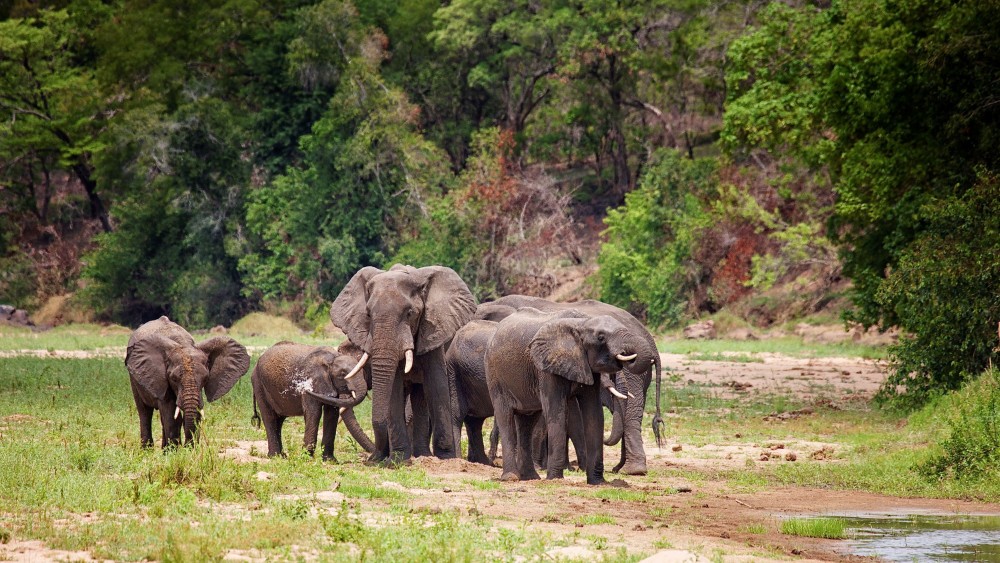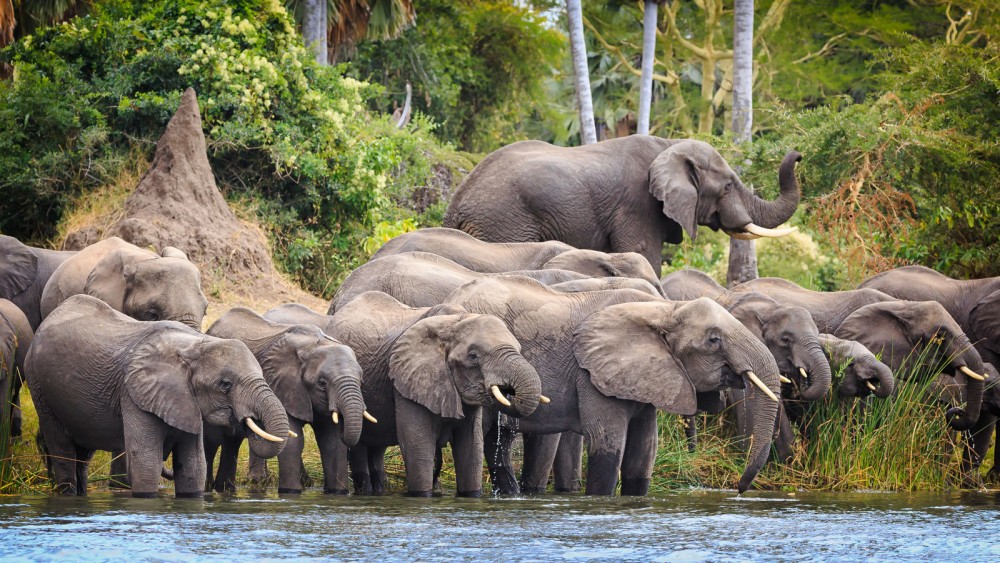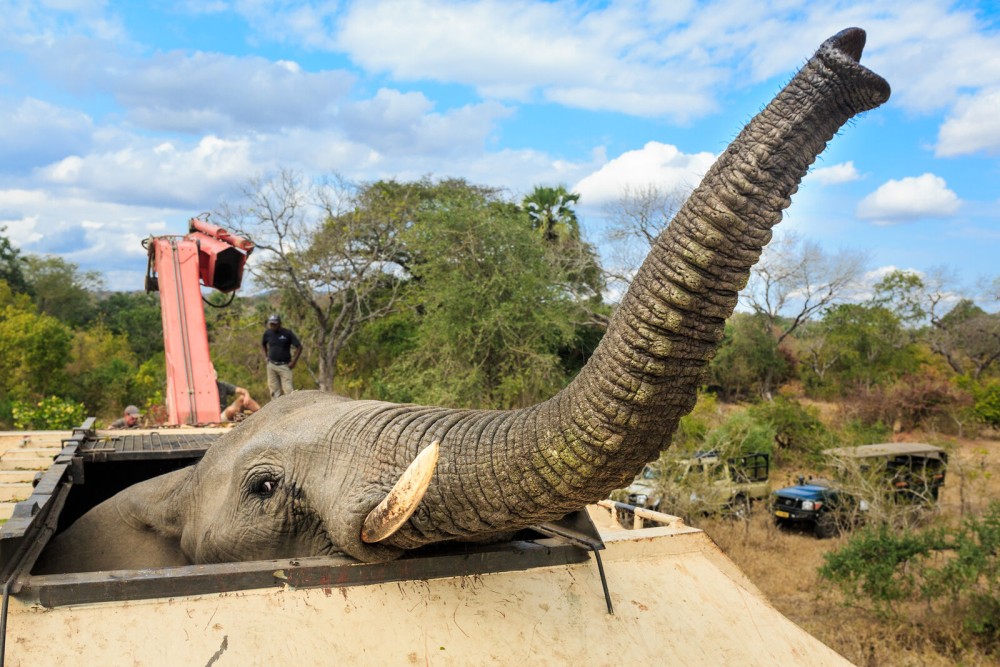More than 520 elephants and 2,000 other animals were moved from Liwonde National Park and Majete Wildlife Reserve to Nkhotakota Wildlife Reserve in northern Malawi between July 2016 and August 2017.
Due to poaching, habitat loss and human-wildlife conflict, elephants are being decimated across Africa, having declined from 10 million a century ago to about 500,000 in 2022. The 500 Elephants Project, however, is part of a different story – one of hope and restoration, of overcoming challenges and of securing the future for Malawi’s elephants.
Nkhotakota Wildlife Reserve once had more than 1,500 elephants, but fewer than 100 remained when we assumed management of the reserve in 2015. Between 2016 and 2017, some 350 elephants from Liwonde National Park and 150 from Majete Wildlife Reserve were moved to Nkhotakota, each elephant travelling approximately 350 km from Liwonde or 600 km from Majete to get to their new home. Thanks to this historic translocation and reintroduction of a key species, Nkhotakota’s once near-empty forests have begun to be restored as functioning and healthy ecosystems.

The 500 Elephant translocation had two objectives: to restock Nkhotakota and to relieve pressure due to the elephant surplus in Liwonde and Majete. Elephants are a keystone species, which means they play a pivotal role in engineering the structure of plant and animal communities and thus ecosystems within their habitats. While this is normally to the benefit of the environment, degradation takes place when populations are too dense and when migration is restricted. As Malawi is a densely-populated agriculture-based country, ecological corridors no longer exist to allow for natural movement for wildlife, so the elephant populations within its protected areas need to be carefully managed to mitigate adverse effects on both the habitat and the surrounding communities.
By 2016, Liwonde National Park and Majete Wildlife Reserve had large elephant populations. Both parks were near to capacity, with approximately 800 in Liwonde and 400 in Majete respectively. Such numbers and density had resulted in habitat destruction and high levels of human-wildlife conflict, largely due to crop-raiding elephants. A ‘human-assisted migration’ was needed to provide the best chance of a long-term and sustainable future for the parks’ elephants by considering them as a ‘source population’ that could feed other areas. Nkhotakota Wildlife Reserve, with fewer than 100 elephants, was a viable ‘sink’ habitat, with sufficient resources to support a large herd of elephants and other animals.
The solution was clear. Translocation – a valuable, resource-intensive conservation management strategy that can be applied to protected areas to actively reduce the risk of species extinction by broadening their range and increasing their numbers – represented the elephants’ best hope for a sustainable future.
How To Move 500 Elephants?

As our highest priority is always ensuring the safety of both people and wildlife, we first overhauled conservation law enforcement in Nkhotakota, to ensure that it was safe for the elephants to return. We also constructed reliable perimeter fencing, working closely with local communities, to decrease the chances of human-wildlife conflict and to ensure that where wildlife thrive, people thrive. The logistics associated with a translocation of this scale and complexity required months of intensive planning and preparation. African Parks undertook this immense task with our expert teams and with contracted professionals from Conservation Solutions to ensure the safety of this precious cargo.
The total distance covered throughout the manoeuvres roughly equated to 125,000 km, equivalent to three times around the world. For this, hundreds of kilometres of roads and river crossings were repaired and constructed within Liwonde, Majete and Nkhotakota to allow for improved vehicle and animal accessibility. Road networks were enhanced to facilitate the construction of the fencing in Nkhotakota, including that of a 19,000-hectare sanctuary and the 180,000 hectares of the wider park. This additional infrastructure was an invaluable asset to all the parks’ tourism capacity and the prevention of human-wildlife conflict. It was also an important source of employment for local communities.
The elephant translocation occurred in phases, each of which was carefully planned to ensure minimal stress for the animals. Elephants were darted by helicopter and retrieved from the field by crane and recovery trucks. They were then awoken in purpose-built ‘wake-up’ crates that were loaded onto four 30-tonne low-bed trucks for their journey to Nkhotakota. On arrival, the elephants were released into a boma – a holding facility with food and water that was surrounded by a perimeter of electric fencing. Following a period of 12 to 24 hours, they were then released into the larger sanctuary.
With such large numbers, the translocation had to take place in two stages. The first, from July 4th to August 16th, 2016, saw 261 elephants moved, while the second occurred between June 17th and August 2nd, 2017, with another 225 elephants being transferred from Liwonde and Majete to Nkhotakota. At the same time, more than 1,500 other animals were moved from Liwonde and Majete to Nkhotakota to increase the diversity in that reserve. This included buffalo, eland, impala, kudu, waterbuck, warthog, sable, zebra and hartebeest.
At this point, the largest elephant translocation in history was concluded.
A project of this scale was logistically challenging and required substantial capacity. What it demonstrated, however, was that scale does not have to be a limitation. This translocation also showcased the extraordinary lengths people from various sectors went to actively protect an endangered species, with immense measures taken to alleviate overstocked parks, restock new parks, and relocate animals from unprotected areas to protected areas. As technology and veterinary innovations improve, and as we learn from experience, we have gathered a body of knowledge that has gone on to facilitate more extensive use of large-scale translocations as a conservation management tool.
Where Wildlife Thrives, People Thrive
Following the translocations, Nkhotakota was revitalised as a wildlife sanctuary, and healthy population dynamics among key species restored in all three reserves. Additionally, the return of the elephants to the park marked its establishment as an important ecotourism attraction, through which tourism revenue flowed and employment opportunities opened to the direct benefit of local communities.
By restoring biological value to these parks, and managing them correctly with our government and tourism partners, both their economic and intrinsic value was made more tangible for local residents to whom the parks belong as part of their natural heritage. Through these restorations, Malawi gained three globally iconic protected areas for wildlife tourism.
Ongoing Challenges
With the decline in ivory poaching since 2017, and reintroductions of elephant into their historical areas, populations have begun recovering and expanding their ranges. But increasing elephants bring their own challenges, namely growing human-elephant conflict – an issue that the communities that live around the Malawi parks are facing. This challenge is being met in a variety of ways, from fencing the park boundaries to attendants patrolling these to ensure breakouts are handled quickly. An innovative deterrent that also generates income is chilli farming next to the park borders. Elephant conservation in the context of high human-wildlife conflict is an ongoing and complex issue, but with continued commitment by African Parks and the Malawian people, and projects like 500 Elephants, there is hope for a future that balances the needs of people and wildlife.

This historic initiative was made possible thanks to the generous support from the following donors and partners of Department of National Parks and Wildlife (DNPW), The Dutch Postcode Lottery, The Wyss Foundation, Wildcat Foundation, Donna and Marvin Schwartz, Dioraphte and People’s Postcode Lottery.
Your Support Goes a Long Way
At African Parks we are working everyday to protect Africa's last wild landscapes. By donating to us, you are making a difference and are giving hope to people and wildlife across the continent.
Donate